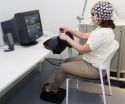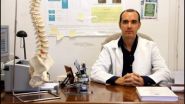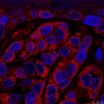(Press-News.org) New research has revealed the causes and warning signs of rare tsunami earthquakes, which may lead to improved detection measures.
Tsunami earthquakes happen at relatively shallow depths in the ocean and are small in terms of their magnitude. However, they create very large tsunamis, with some earthquakes that only measure 5.6 on the Richter scale generating waves that reach up to ten metres when they hit the shore.
A global network of seismometers enables researchers to detect even the smallest earthquakes. However, the challenge has been to determine which small magnitude events are likely to cause large tsunamis.
In 1992, a magnitude 7.2 tsunami earthquake occurred off the coast of Nicaragua in Central America causing the deaths of 170 people. Six hundred and thirty seven people died and 164 people were reported missing following a tsunami earthquake off the coast of Java, Indonesia, in 2006, which measured 7.2 on the Richter scale.
The new study, published in the journal Earth and Planetary Science Letters, reveals that tsunami earthquakes may be caused by extinct undersea volcanoes causing a "sticking point" between two sections of the Earth's crust called tectonic plates, where one plate slides under another.
The researchers from Imperial College London and GNS Science in New Zealand used geophysical data collected for oil and gas exploration and historical accounts from eye witnesses relating to two tsunami earthquakes, which happened off the coast of New Zealand's north island in 1947. Tsunami earthquakes were only identified by geologists around 35 years ago, so detailed studies of these events are rare.
The team located two extinct volcanoes off the coast of Poverty Bay and Tolaga Bay that have been squashed and sunk beneath the crust off the coast of New Zealand, in a process called subduction.
The researchers suggest that the volcanoes provided a "sticking point" between a part of the Earth's crust called the Pacific plate, which was trying to slide underneath the New Zealand plate. This caused a build-up of energy, which was released in 1947, causing the plates to "unstick" and the Pacific plate to move and the volcanoes to become subsumed under New Zealand. This release of the energy from both plates was unusually slow and close to the seabed, causing large movements of the sea floor, which led to the formation of very large tsunami waves.
All these factors combined, say the researchers, are factors that contribute to tsunami earthquakes. The researchers say that the 1947 New Zealand tsunami earthquakes provide valuable insights into what geological factors cause these events. They believe the information they've gathered on these events could be used to locate similar zones around the world that could be at risk from tsunami earthquakes. Eyewitnesses from these tsunami earthquakes also describe the type of ground movement that occurred and this provides valuable clues about possible early warning signals for communities.
Dr Rebecca Bell, from the Department of Earth Science and Engineering at Imperial College London, says: "Tsunami earthquakes don't create massive tremors like more conventional earthquakes such as the one that hit Japan in 2011, so residents and authorities in the past haven't had the same warning signals to evacuate. These types of earthquakes were only identified a few decades ago, so little information has been collected on them. Thanks to oil exploration data and eyewitness accounts from two tsunami earthquakes that happened in New Zealand more than 70 years ago, we are beginning to understand for first time the factors that cause these events. This could ultimately save lives."
By studying the data and reports, the researchers have built up a picture of what happened in New Zealand in 1947 when the tsunami earthquakes hit. In the March earthquake, eyewitnesses around Poverty Bay on the east coast of the country, close to the town of Gisborne, said that they didn't feel violent tremors, which are characteristic of typical earthquakes. Instead, they felt the ground rolling, which lasted for minutes, and brought on a sense of sea sickness. Approximately 30 minutes later the bay was inundated by a ten metre high tsunami that was generated by a 5.9 magnitude offshore earthquake. In May, an earthquake measuring 5.6 on the Richter scale happened off the coast of Tolaga Bay, causing an approximate six metre high tsunami to hit the coast. No lives were lost in the New Zealand earthquakes as the areas were sparsely populated in 1947. However, more recent tsunami earthquakes elsewhere have devastated coastal communities.
The researchers are already working with colleagues in New Zealand to develop a better warning system for residents. In particular, new signage is being installed along coastal regions to alert people to the early warning signs that indicate a possible tsunami earthquake. In the future, the team hope to conduct new cutting-edge geophysical surveys over the sites of other sinking volcanoes to better understand their characteristics and the role they play in generating this unusual type of earthquake.
INFORMATION:
For further information please contact:
Colin Smith
Senior Research Media Officer
Communications and Public Affairs
Imperial College London
South Kensington Campus
London SW7 2AZ
Tel: +44 (0)20 7594 6712
Email: cd.smith@imperial.ac.uk
Duty press officer mobile: +44 (0)7803 886248
Notes to editors:
1. "Hikurangi margin tsunami earthquake generated by slow seismic rupture over a subducted seamount" Earth and Planetary Science Letters
Rebecca Bell, [1], Caroline Holden [2], William Power [2], Xiaoming Wang [2]. Gaye Downes [2] [1] Department of Earth Science and Engineering, Imperial College London, SW7 2BP, UK [2] GNS Science, 1 Fairway Drive, Avalon, Lower Hut 5010, New Zealand
2. About Imperial College London
Consistently rated amongst the world's best universities, Imperial College London is a science-based institution with a reputation for excellence in teaching and research that attracts 14,000 students and 6,000 staff of the highest international quality. Innovative research at the College explores the interface between science, medicine, engineering and business, delivering practical solutions that improve quality of life and the environment - underpinned by a dynamic enterprise culture.
Since its foundation in 1907, Imperial's contributions to society have included the discovery of penicillin, the development of holography and the foundations of fibre optics. This commitment to the application of research for the benefit of all continues today, with current focuses including interdisciplinary collaborations to improve global health, tackle climate change, develop sustainable sources of energy and address security challenges.
Imperial College London press-release mailing list
Sign up to Imperial Twitter at: http://twitter.com/imperialcollege and http://twitter.com/imperialspark
Sign up for Imperial RSS feeds at:
http://www3.imperial.ac.uk/imperialnews/RSS_14150300.xml
More media resources online at: http://www.imperial.ac.uk/media
Search for experts at: http://www.imperial.ac.uk/mediaguide
To unsubscribe from this list please reply with 'unsubscribe' in the subject header
Extinct undersea volcanoes squashed under Earth's crust cause tsunami earthquakes, according to new
New research has revealed the causes and warning signs of rare tsunami earthquakes, which may lead to improved detection measures
2014-06-27
ELSE PRESS RELEASES FROM THIS DATE:
A study warns of the risk entailed when night owls -- 'evening-type' people -- drive early in the morning
2014-06-27
Researchers from the University of Granada have shown that individual chronotype—that is, whether you are a "morning-type" or an "evening-type", depending on the time of day when your physiological functions are more active—markedly influences driving performance.
In fact, evening-types are much worse drivers—they pay less attention—at their "non-optimal" time of day (early in the morning) by comparison with their optimal time (during the evening). However, in this experiment morning-types were more stable drivers than evening-types and drove relatively well both in the ...
Colon cancer survivors are more likely to have pain in the back and abdomen
2014-06-27
Researchers from the University of Granada have discovered that colon cancer survivors are more likely to suffer future lesions related with pain in the back and lower abdomen than healthy individuals of the same gender and age.
These patients present a series of abnormalities in the abdominal wall architecture—the site of surgery in oncological treatment. Moreover, they have specific abnormalities in processing chronic pain that may increase their sensitization to any kind of pain in the future.
In two articles published in Pain Medicine and the European Journal of ...
'Big data' technique improves monitoring of kidney transplant patients
2014-06-27
A new data analysis technique radically improves monitoring of kidney patients, according to a University of Leeds-led study, and could lead to profound changes in the way we understand our health.
The research, published in the journal PLoS Computational Biology, provides a way of making sense out of the huge number of clues about a kidney transplant patient's prognosis contained in their blood.
By applying sophisticated "big data" analysis to the samples, scientists were able to crunch hundreds of thousands of variables into a single parameter indicating how a kidney ...
Global healthcare is a labour of Hercules
2014-06-27
Einstein once observed that "it is harder to crack prejudice than an atom". If he was right, then Hans Rosling is faced with a labour of Hercules. As Professor of International Health at the Karolinska Institute in Stockholm, he finds himself fighting against the cliché that the world is divided between rich and poor. "This neat division simply no longer exists. The statistics reveal a far more complex picture, with more and more people worldwide living in relative prosperity. This means that in health research in particular it is time for a paradigm shift," says Rosling. ...
Sex hormone levels at midlife linked to heart disease risk in women
2014-06-27
PITTSBURGH, June 27, 2014 – As hormone levels change during the transition to menopause, the quality of a woman's cholesterol carriers degrades, leaving her at greater risk for heart disease, researchers at the University of Pittsburgh Graduate School of Public Health discovered.
The first-of-its-kind evaluation, supported by the National Institutes of Health (NIH), was done using an advanced method to characterize cholesterol carriers in the blood and is published in the July issue of the Journal of Lipid Research.
The results call for further research to evaluate ...
New form of brain signaling affects addiction-related behavior
2014-06-27
University of Iowa researchers have discovered a new form of neurotransmission that influences the long-lasting memory created by addictive drugs, like cocaine and opioids, and the subsequent craving for these drugs of abuse. Loss of this type of neurotransmission creates changes in brains cells that resemble the changes caused by drug addiction.
The findings, published June 22 in the journal Nature Neuroscience, suggest that targeting this type of neurotransmission might lead to new therapies for treating drug addiction.
"Molecular therapies for drug addiction are ...
Homeless alcoholics typically began drinking as children
2014-06-27
WASHINGTON — A phenomenological study offers detailed insights into homeless, alcohol-dependent patients often stigmatized by the public and policymakers as drains on the health care system, showing the constellation of reasons they are incapable of escaping social circumstances that perpetuate and exacerbate their problems The study, published online yesterday in Annals of Emergency Medicine, was conducted at Bellevue Hospital in New York City, which has a long history of service to the city's indigent population.
"One hundred percent of patients enrolled in the study ...
CNIO researchers discover more than 40 melanoma-specific genes that determine aggressiveness
2014-06-27
Researchers from the Spanish National Cancer Research Centre (CNIO) have discovered more than 40 genes that predict the level of aggressiveness of melanoma and that distinguish it from other cancers with a poor prognosis. The discovery, published in Cancer Cell, will help to identify unique aspects of melanoma that could contribute to determine the risk of developing metastasis in patients with this disease. This study is relevant because it explains why a drug, also described by CNIO, is being used to selectively attack the melanoma tumour cells. Melanoma is one of the ...
NIH scientists establish proof-of-concept for host-directed tuberculosis therapy
2014-06-27
WHAT:
In a new study published in Nature, scientists describe a new type of tuberculosis (TB) treatment that involves manipulating the body's response to TB bacteria rather than targeting the bacteria themselves, a concept called host-directed therapy. TB remains a major cause of disability and death worldwide as an estimated 8.6 million people fell ill with TB and 1.3 million people died from the disease in 2012, according to the World Health Organization. Although TB is curable, adherence to therapy is difficult as treatment requires taking antibiotic drugs for at least ...
Walking the rocks: GSA Today article studies undergraduate field education
2014-06-27
Boulder, Colorado, USA – In the July 2014 issue of GSA Today, Heather Petcovic of Western Michigan University and colleagues Alison Stokes and Joshua Caulkins examine the question of geoscientists' perceptions of the value of undergraduate field education. Despite being perceived as integral to both geoscience learning and professional preparation, little research exists on the types of field experiences that carry the most value.
In their study, Petcovic and colleagues compile and analyze survey data obtained during two Geological Society of America (GSA) annual meetings ...
LAST 30 PRESS RELEASES:
Strategic river sensors could have forewarned of Texas Camp flood disaster
Drone sampling of whale breath reveals first evidence of potentially deadly virus in Arctic
Roman soldiers defending Hadrian’s Wall infected by parasites, study finds
Pinochet’s prisoners were tormented with music but still found solace in it, a new book reveals
Fertility remains high in rural Tanzania despite access to family planning
AI-assisted device can improve autism care access
Kinetic careers
Uncovering how parasitic plants avoid attacking themselves to improve crop resistance
Nanoparticle vaccine strategy could protect against Ebola and other deadly filoviruses
Study finds brain care score can predict risk of stroke across racial groups
Key lung immune cells can intensify allergic reactions
Do hormones explain why women experience more gut pain?
New materials conduct ions in solids as easily as in liquids
Breakthrough of the Year: Renewable energy begins to eclipse fossil fuel-based sources
LLM use is reshaping scientific enterprise by increasing output, reducing quality and more
Introducing LightGen, a chip for ultra-fast, ultra-efficient generative AI
Astronomers see fireworks from violent collisions around nearby star
ACC/AHA issue new guideline on managing congenital heart disease in adults
Cosmic crash caught on camera
Is talented youth nurtured the wrong way? New study shows: top performers develop differently than assumed
Ants: An untapped resource in the development of antibiotics?
Archaeologists use AI to create prehistoric video game
Mitochondria migrate toward the cell membrane in response to high glucose levels
Tiny viral switch offers hope against drug-resistant bacteria
Most parents aware of early peanut introduction guidelines, but confused about details
HPV vaccine can protect against severe lesions of the vulva and vagina
Virtual care provision and emergency department use among children and youth
Quadrivalent HPV vaccine and high-grade vulvovaginal lesions
Insights into dry eyes gained from stem cell-derived tear glands
Researchers identify 166 human pluripotent stem cell lines available for use in clinical applications
[Press-News.org] Extinct undersea volcanoes squashed under Earth's crust cause tsunami earthquakes, according to newNew research has revealed the causes and warning signs of rare tsunami earthquakes, which may lead to improved detection measures


